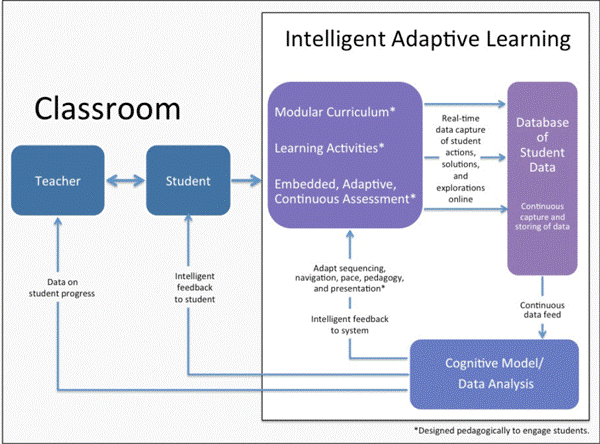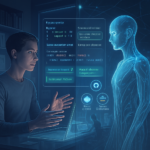Eighteen students sit in a classroom in front of 18 computers. The students log into their computers, and silently begin working, while in the back of the room; the instructor sits in front of a computer looking at a series of spreadsheets and data visualizations to track each student’s progress in real time.
Is this real, or just a dream? It is a real pre-algebra class at a community college.
The instructor does not lecture. Instead, she serves as a roving tutor. As the students work, the software logs everything from which questions the students get right and wrong to the amount of time they spend on each one. Of significance, the tool starts everyone at the same point, but as they answer the questions, machine-learning algorithms are analyzing responses to figure out which concepts they understand and which they don’t.
This is vastly different from the traditional classroom many of us grew up in, in which instructors lecture, students listen and everyone hears the same thing.1
Education Comes of Age
Education has lagged many industries such as manufacturing, finance and healthcare for a long time in use of digital technology. However, its adoption is growing at a significant pace.
That is a good part of the message.
On the other hand, a common set of practices and planning is lacking in education’s transformation to the digital age, which makes its effectiveness inconsistent.
Technology has shown significant progress over the last few years:2
- Public schools in the US now provide at least one computer for every five students
- Schools are spending more than $3 billion per year on digital content
- Led by the federal government, the country is going through a massive effort to make affordable high-speed Internet and free online teaching resources available to even remote areas of the country
- In 2015-16, more state standardized tests for K-12 will be administered via technology rather than by paper and pencil
Currently, digital learning is where smartphones were over 10 years ago.
Adoption is taking hold, and it is proving value along some dimensions. The opportunities are becoming real as noted in the opening situation. But there are many more that are on the horizon, some beyond our imaginations.
It could be a decade from now that digital learning capabilities, we once thought of as emerging, will be where smartphones are today.
For the first time in six years, The U.S, Department of Education issued a National Education Technology Plan, at the direction of President Barack Obama.
Past plans did more to evaluate the application and advantages of technology than to establish a clear-cut direction of its use. The latest plan notes the conversation has shifted from whether technology should be used in learning, to how it can improve learning to ensure all students have access to high-quality educational experiences.3
The technology plan breaks down into the following five key areas of digital transformation success in education:
- Learning: Engaging and empowering learning through technology
- Teaching: Teaching with technology
- Leadership: Creating a culture and conditions for innovation and change
- Assessment: Measuring for learning
- Infrastructure: Enabling access and effective use
The plan notes the type of changes that need to occur from traditional methods of learning to methods in the digital age. Examples of what changes need to occur are illustrated in the following graphic regarding the future of assessment.

Another area seeing significant change and value from technology is in adaptive learning. Adaptive learning is defined as digital learning that immerses students in modular learning environments where every decision a student makes is captured, considered in the context of learning theory and used to guide the student’s learning experiences. The opening situation at the community college is an example of adaptive learning.
The following chart illustrates the low of how it works:

Value in Digital Learning
Experiences show the value of the digital transformation in education.
Some of these experiences include:
- Teachers can collaborate to share their ideas and resources online
- Students can develop valuable research skills at a young age
- Students and teachers have access to an expanse of material
- Online learning is now an equally credible option to face-to-face learning
- Based on research, technology improves student learning outcomes
The question is no longer if technology enhances learning, but rather how do we improve its effectiveness to enhance learning.
Key Barriers
As any change, there are barriers to success.
- Lack of infrastructure capable of enabling digital learning platforms
- Instructor resistant to new ways of teaching
- Leadership in local government and school administrators to drive the change
- Professional development for instructors to learn. Training is brief, if done at all
- Design of the instruction to mix digital with traditional means of learning. This accounts for more differences in how and why people learn than the technology itself
Impact on the Education Eco-system
From a publisher’s perspective, the world is changing from producing books to developing software. This includes the major publishers such as Pearson and McGraw-Hill Education. They now understand the promise and value of digital learning, and they are changing their strategies from being a publisher to that of a provider of learning.
There are other areas of the eco-system that are facing a similar amount of change in the digital transformation in education, including government, district and school administrators.
The CITed Research Center, after doing studies on the effectiveness of digital implementations, offers the following lessons learned for technology implementation providers in education4:
- Train with the classroom in mind: Integrate the curriculum and daily activities into the professional development designed to teachers gain expertise with technology tools.
- Do your homework: Make sure the district or school is ready to take on a new initiative with administrative buy-in and well-defined conditions identified for improvement
- Make It happen: Assemble a team of sufficient breadth and cross-disciplinary expertise, supported by the district, to take on the responsibility to implement the initiative fully
- Set realistic goals: Understand that change takes time and that infrastructure needs to be built during implementation to get to scaling-up and sustainability
- Differentiate the professional development: Recognize that best practice indicates that teachers have different needs and levels of expertise, and design multilayered, multimodal professional development
- Find partners: Look for simultaneous initiatives running in the district and identify areas of convergence and synergy
Transformation is Coming
There is no doubt that digital transformation is taking place in education, and its impact is significant. Examples of success are numerous, and barriers have been clearly understood. It is only a matter of time that the full impact of this digital transformation in education comes to fruition.
Sources:
1 Oremus, Will. “The Textbook Is Dying. Meet the Artificially Intelligent Software That’s Replacing It. .” Slate Magazine. N.p., 25 Oct. 2015. Web. 07 June 2016. http://www.slate.com/articles/technology/technology/2015/10/adaptive_learning_software_is_replacing_textbooks_and_upending_american.html.
2 Herold, Benjamin. “Technology in Education: An Overview.” Education Week. Editorial Projects In Education, n.d. Web. 07 June 2016. http://www.edweek.org/ew/issues/technology-in-education/
3 National Education Technology Plan – Office of Educational Technology.”Office of Educational Technology. N.p., n.d. Web. 07 June 2016. http://tech.ed.gov/netp/.
4 “Lessons Learned for Effective Technology Implementation.” Cited Research. Research Center – Center for Implementing Technology in Education, n.d. Web. 07 June 2016. http://www.cited.org/index.aspx?page_id=206.
About the Author:






Trackbacks/Pingbacks